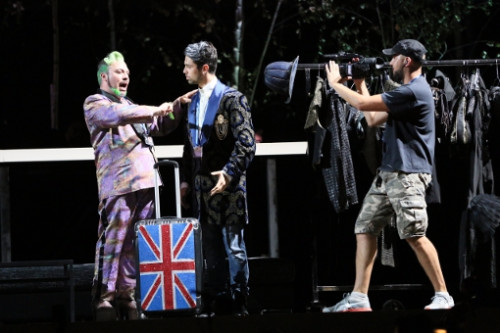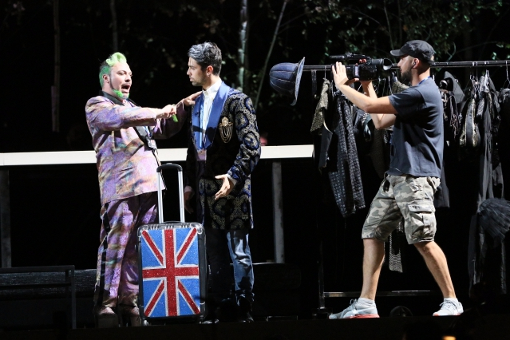 Italy Festival della Valle d’Itria [3] – Meyerbeer, Margherita d’Anjou: Soloists of the Festival della Valle d’Itria, Coro del Teatro Municipale di Piacenza, Orchestra Internazionale d’Italia / Fabio Luisi (conductor), Palazzo Ducale, Festival della Valle d’Itria, Martina Franca, Puglia, 2.8.2017. (VV)
Italy Festival della Valle d’Itria [3] – Meyerbeer, Margherita d’Anjou: Soloists of the Festival della Valle d’Itria, Coro del Teatro Municipale di Piacenza, Orchestra Internazionale d’Italia / Fabio Luisi (conductor), Palazzo Ducale, Festival della Valle d’Itria, Martina Franca, Puglia, 2.8.2017. (VV)

Cast:
Margherita – Giulia De Blasis
Edoardo (Margherita’s son) – Arcangelo Carbotti
Duke of Lavarenne – Anton Rositskiy
Isaura – Gaia Petrone
Riccardo, Duke of Gloucester – Bastian Thomas Kohl
Carlo Belmonte – Laurence Meikle
Michele Gamautte – Marco Filippo Romano
Gertrude – Elena Tereshchenko
Bellapunta – Lorenzo Izzo
Orner – Dielli Hoxha
An officer – Massimiliano Guerrieri
Fattoria Vittadini dancers choreographed by Riccardo Olivier
Production:
Director – Alessandro Talevi
Sets and costumes – Madeleine Boyd
Costumes – Giuseppe Palella
Lighting designer – Giuseppe Calabrò
Chorus master – Corrado Casati
This production of Margherita d’Anjou by the Festival della Valle d’Itria (now in its forty-third year) is the first fully staged modern-day revival of the opera. A concert performance took place at the Royal Festival Hall in 2002 and a recording was released in 2003 by Opera Rara; in 2015 Ricordi Berlin published a critical edition of the score by Paolo A. Rossini and Peter Kaiser, in light of the different versions and annotations made by Meyerbeer (1791-1864) in the years following the 1820 première. The opportunity to see this melodramma semiserio (in the 2015 Ricordi edition) on stage is therefore of obvious historical interest.
Margherita was written for La Scala during Meyerbeer’s Italian sojourn (1816-1825). It offers an intriguing snapshot of the young composer developing his own style. The influence of Rossini is indisputable, but so are the early signs of a personal imprint which will become more marked and recognisable in his grands opéras. It is the first of his operas to have a historical subject. Both the vocal and instrumental parts are highly virtuosistic. And the music and text are closely integrated: as the Meyerbeer scholar Letellier reminds us, ‘his concern was always for the complete Gestalt, […] what in the Romantic artistic ideal is called the Gesamtkunstwerk’ (The Operas of Giacomo Meyerbeer, 2006, p.19). Despite that, Margherita suffers from flaws which must account for the lack of performances of it after the international success of its first decade.
The libretto is by Felice Romani (1788-1865), who will also write for, amongst others, Bellini and Donizetti. This time, he adapts a text of 1810 by de Pixérécourt (1773-1844), loosely based on the life of Margaret of Anjou (1430-1482), wife of King Henry VI of England. The resulting plot juxtaposes the national-political and private spheres, but is dramatically weak: the build-up essential to believable character motivations and development, sequence and speed of action or utterances is at best inconsistent. The shifts between the serious and the comical of the semiseria form create challenges, too.
The director of this production is the South African Alessandro Talevi, whose credits include, amongst others, Don Giovanni and La traviata for Opera North, Anna Bolena and Roberto Devereux for WNO, and Histoire du Soldat and Albert Herring for Maggio Musicale Fiorentino. The sets and costumes are by Madeleine Boyd, who has worked with him on other productions, too. The team moves the action to the present day, and specifically to the worlds of fashion, reality TV, press moguls and paparazzi. This highlights two particularly valuable insights: that Margherita’s status as an ‘icon’ affects all the relationships between her and other characters – especially Lavarenne – and that the comic role of Michele Gamautte can function as a useful connecting thread between disparate elements (as comparable characters notably do in Shakespeare). So Margherita here is a successful designer presenting her collection at London Fashion Week; Lavarenne is a pop singer seemingly in love with her, and on whose efforts to defend her from an inimical press owned by Gloucester she relies; Isaura is Lavarenne’s wife, in disguise to win him back; Michele Gamautte is the reality TV host pivotal to the resolution of both the political and personal narrative arcs. This makes sense of otherwise problematic aspects of the opera. Above all, underlining how Lavarenne’s passion for Margherita is rooted in a mix of admiration for the diva and of sympathy for her struggle against Gloucester, renders credible the speed with which he is won over by his wife’s tenderness: the warmth and sincerity of real love expose the flimsy basis of the replica.
Despite these considerable merits, transferring the story to today’s fashion world creates fresh difficulties. The setting sits awkwardly with the music and the libretto. The first act is strongly marked by military music and textual references to armies and battles, but, on stage, fashion models strut down a catwalk or dance at a rave. In the quieter second act, Margherita and her entourage find refuge at a luxury spa; however, the pastoral themes of the Highland villagers and Margherita’s great aria ‘Dolci alberghi di pace’ are both celebrating the idyll of nature and a simple life – a life which Margherita’s public role puts beyond her reach, to her sorrow and sense of isolation.
Musically, the work is not only fascinating, but filled with exquisite and inventive parts for solo voices, chorus and individual instruments. The vocal agility required of the soloists is phenomenal, and the whole cast rises ably to that challenge. There is an unusual, semiserio trio of basses. There are extended ensembles which begin with trios and flow into sextets reminiscent of Rossini and Mozart. The violin obbligato (soloist: Pacalin Pavaci) for Margherita’s ‘Dolci alberghi di pace’ is breathtakingly virtuosistic, and the effect of the interplay between the two lines is arrestingly beautiful and touching. The chorus is superb and thoroughly integrated into the action. The conductor is Fabio Luisi, currently General Music Director of Zurich Opera and Principal Conductor of the Danish National Symphony Orchestra; previous roles include that of Principal Conductor of the Metropolitan Opera. The orchestra’s responsiveness to him results in an impeccable balance of sound between it and the singers.
Giulia De Blasis as Margherita gives us fluid passaggi and precise coloratura, with sumptuous resonance in the top notes. Her performance shows us the two aspects of the queen: outwardly, the ‘icon’; inwardly, the beleaguered, insecure and isolated individual. Gaia Petrone’s warmth of tone and the seeming effortlessness of her leaps across the octaves are ideal qualities for the part of Isaura. There is a naturalness to her acting which fills in gaps in the text and the music, lending depth to her exchanges with other characters. Anton Rositskiy triumphs over the spectacular tessitura and top notes of the Duke of Lavarenne role. Bastian Thomas Kohl endows Richard, Duke of Gloucester, with the dark tone and gravitas of Margherita’s redoubtable enemy. Laurence Meikle portrays Carlo Belmonte convincingly as the vassal who reluctantly betrays his queen but who eventually gives her his allegiance again, saving her and her child. The quasi-duet between Carlo and Margherita in Act I, Scene 2, is one of the high points of the score. Marco Filippo Romano is vocally and dramatically excellent in the buffo part of Gamautte, a character whose complexity is brought to the fore and deployed to its full potential in this production.
Valeria Vescina
